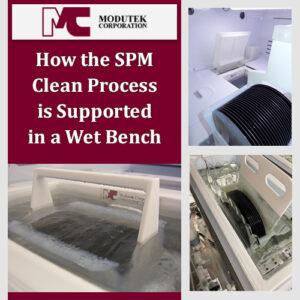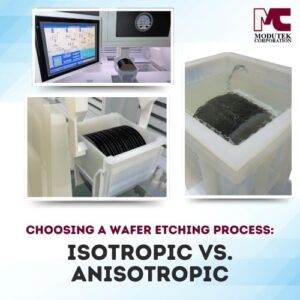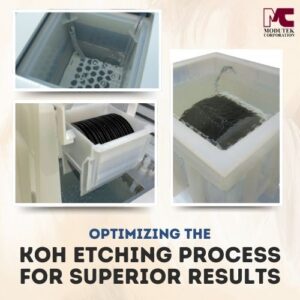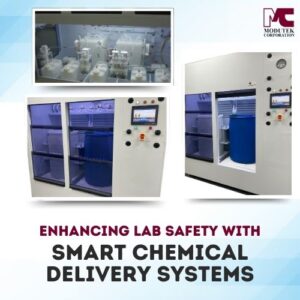 Editor’s Note: This article was originally published in Oct 2016 and has been updated with additional information and reposted in May 2023.
Editor’s Note: This article was originally published in Oct 2016 and has been updated with additional information and reposted in May 2023.
Semiconductor manufacturing involves multiple processing steps which include cleaning silicon wafers. The sulfuric peroxide mix (SPM) cleaning process is widely utilized in semiconductor manufacturing. The process utilizes a mixture of approximately 3 parts sulfuric acid to 1 part hydrogen peroxide which is highly effective at eliminating organic and inorganic contaminants from semiconductor wafers. The SPM process is typically performed in wet benches specifically designed for this cleaning process.
The SPM Clean Process
Sulfuric acid in the SPM solution reacts with organic contaminants like photoresist and residue, while hydrogen peroxide oxidizes and removes inorganic contaminants like metal ions and particles from semiconductor wafers. This reaction generates heat which helps to accelerate cleaning. Process engineers using the SPM process in semiconductor manufacturing need to make sure that the chemical ratio and temperature are maintained within safe limits and that the solution and wafers are contained safely in impervious baths. During the process concentration levels may vary from 3 to 1 to a maximum of 7 to 1 and the temperature used may be as high as 140 degrees centigrade. When the solution operating values are chosen, the baths should be maintained at those concentration and temperature values to keep the strip rate uniform.
Advantages of SPM Clean
SPM Clean offers several advantages over other cleaning methods. Its key advantage lies in its effectiveness at removing organic and inorganic contaminants simultaneously. The process is relatively quick usually taking just a few minutes. In addition, the SPM clean process does not damage or etch the substrate beneath, making it ideal for sensitive materials like silicon dioxide and silicon nitride.
Equipment for the SPM Process
SPM cleaning solutions are typically applied in a wet bench designed specifically to facilitate this cleaning method, typically composed of materials compatible with SPM solutions like polypropylene, Teflon, and quartz. Wet benches come equipped with safety features such as fume hoods, exhaust systems, and emergency shutoff switches to help minimize chemical exposure. For consistent and reliable results, SPM clean process equipment typically features process control and automation features to facilitate consistent operations. SPM solution concentration, temperature, and flow rate can all be carefully managed in order to ensure an efficient cleaning process. In addition, automated wafer handling systems may also help minimize contamination risks while improving process efficiencies.
Safety Considerations
To ensure the safe and effective implementation of the SPM Clean process in wet benches, certain practices should be observed. These include adhering to safety procedures, performing regular equipment and tool maintenance checks, optimizing cleaning process performance, and complying with local regulations for waste management and disposal.
Using the SPM Clean Process in Modutek’s Wet Benches
Modutek provides manual, semi-automatic, and fully automatic wet bench systems that support the SPM clean process. Wet Bench systems are available in a wide variety of configurations as well as in custom designs. The fully automated stations use Modutek’s in-house software for automatic process execution with high accuracy, reliability, and repeatability. The semi-automated stations can achieve similar results with robotic controls at a lower cost. The manual stations have the same safety and process features without the cost of automation.
Quartz Recirculating Baths
To work well, the SPM solution must be heated rapidly in a bath that can withstand high temperatures and that will not react with aggressive chemicals. Heating must be even and controlled within a narrow range. At high temperatures, hydrogen peroxide decomposes and the solution must be spiked with more peroxide to maintain its concentration.
Quartz recirculating baths fulfill all these requirements. The quartz can be manufactured in a pure enough form to withstand the temperatures and corrosion while the recirculation allows tight control of concentration with the addition of chemicals as required.
This spiking allows operators to use the solution for a longer period of time rather than discarding the solution when the concentration falls below acceptable levels. Re-using sulfuric acid for as long as possible reduces costs and is desirable from an environmental point of view as well.
Modutek Series QFa Series Quartz Baths
Modutek’s quartz baths support the SPM Clean process and satisfy key conditions for high safety and reliability as well as low cost of ownership. The tanks are made of semiconductor-grade flame-polished quartz and are insulated with high-density alumina-silica fiber rated to 1260 degrees centigrade. The four-sided heating element promotes fast, even heating and the seamless sloped flange and the dual safety snap switch help ensure safe and convenient operation.
The quartz baths have an operating temperature range of 30 to 180 degrees centigrade and they feature a standard heat-up rate of 2 degrees centigrade per minute. The operating temperature can be controlled to within plus/minus 1-degree centigrade and a liquid level sensor is available as an option.
Standard tanks are available in dimensions ranging from 7.75 to 21.5 inches inner side length and in square and rectangular formats. Depths range from 6.75 to 14.5 inches and available heaters are rated 2 to 6 KW. Modutek can design systems with custom vessel sizes to satisfy specific requirements.
The Bottom Line
Modutek’s wet benches and quartz baths are designed with low cost of ownership in mind while emphasizing features that reduce errors and improve reliability. Semiconductor manufacturers using the SPM process can achieve higher throughput and better output quality using Modutek’s equipment. Contact Modutek for a free consultation or quote on wet bench equipment to support your wafer cleaning processes.




